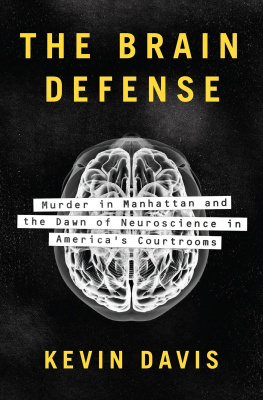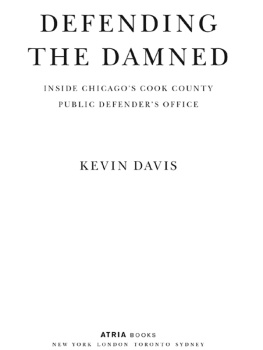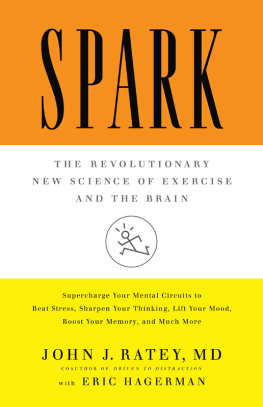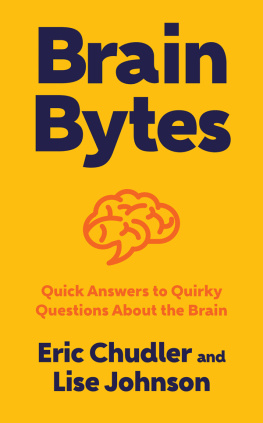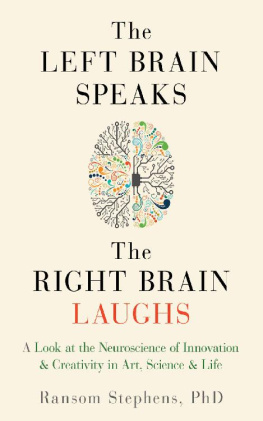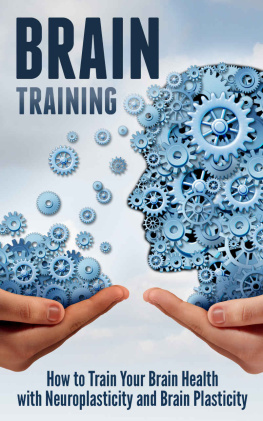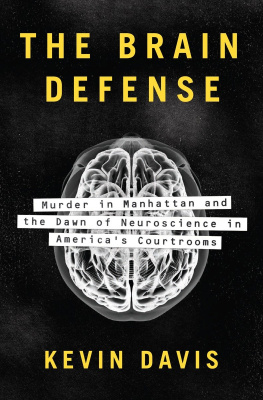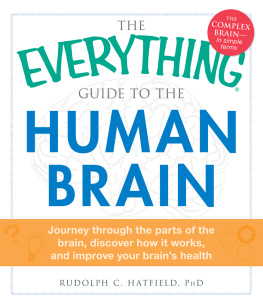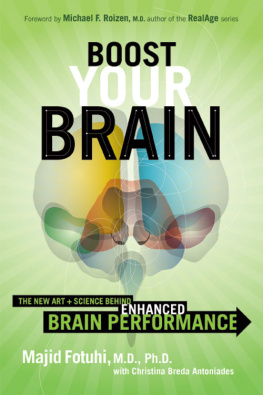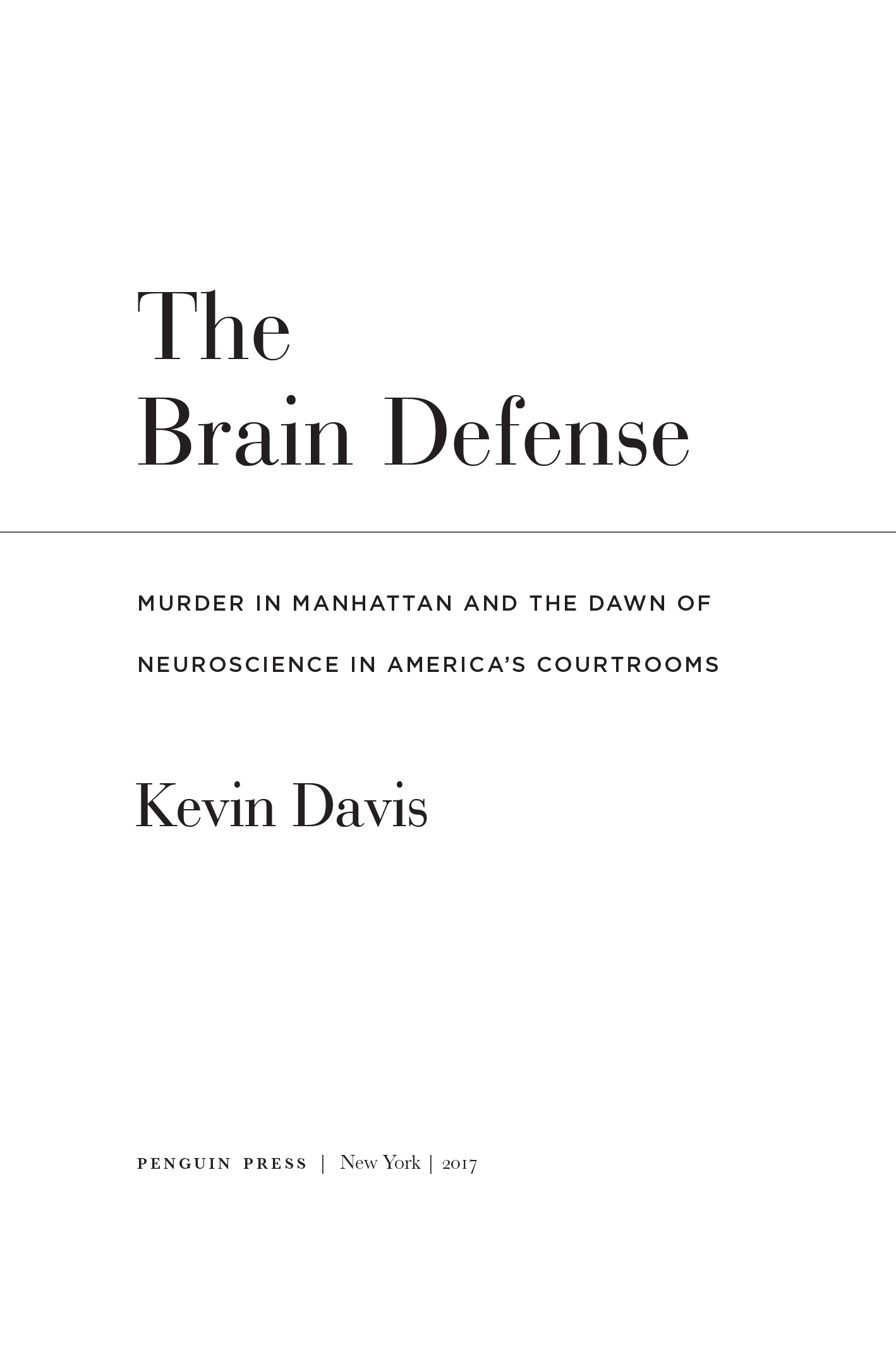Penguin supports copyright. Copyright fuels creativity, encourages diverse voices, promotes free speech, and creates a vibrant culture. Thank you for buying an authorized edition of this book and for complying with copyright laws by not reproducing, scanning, or distributing any part of it in any form without permission. You are supporting writers and allowing Penguin to continue to publish books for every reader.
Names: Davis, Kevin (Kevin A.), author.
Title: The brain defense : murder in Manhattan and the dawn of neuroscience in Americas courtrooms / Kevin Davis.
Description: New York : Penguin Press, 2017.
Identifiers: LCCN 2016043485 (print) | LCCN 2016044316 (ebook) | ISBN 9781594206337 (hardback) | ISBN 9780698183353 (ebook)
Subjects: LCSH: Weinstein, HerbertTrials, litigation, etc. | Trials (Murder)New York (State)New York. | Insanity (Law)New York (State). | Forensic neurologyNew York (State). | BrainDiseasesLaw and legislationNew York (State). | BISAC: LAW / Criminal Law / General. | PSYCHOLOGY / Cognitive Psychology. | POLITICAL SCIENCE / Public Policy / General.
Classification: LCC KF224.W395 D38 2017 (print) | LCC KF224.W395 (ebook) | DDC 345.747/02523dc23
Introduction
O n December 17, 2014, Eric Williams, a former justice of the peace in the small town of Kaufman, Texas, was sentenced to death for assassinating a local district attorney, his wife, and a prosecutor. The killings, which had terrorized the town, were part of a complicated revenge plot for which Williamss wife, Kim, was also convicted. A month after a judge ordered Williams sent to death row, his defense lawyer declared that newly discovered evidence showed his clients brain was broken and demanded a new trial. Attorney John Wright filed a motion in court stating an MRI had revealed that part of Williamss brain had atrophied due to prior head trauma, thus impairing his ability to regulate his emotions, behavior, and judgment. The judge denied the motion for a new trial.
Williamss broken brain claim was another in a growing number of attempts to bring neuroscience into the nations courtrooms to explain or diminish a defendants criminal responsibility. Defense attorneys are looking to neuroscience, and hiring experts, to support claims of brain dysfunctionwhether caused by traumatic brain injury (TBI), a tumor, cancer, drug or alcohol abuse, or a genetic anomalyand argue that the effects should be considered in determining their clients culpability and the severity of their sentences. The number of such cases has risen steadily in the past decade. Nearly 1,600 judicial opinions issued in U.S. courts between 2005 and 2012 mention neurobiological evidence, such as images of a persons brain structure, its level of functioning, or the presence of abnormalities, according to Nita Farahany, a professor of law and philosophy at Duke University. In more than 250 opinions issued in 2012, defendants argued that their brains made them do it, more than double the number five years earlier. Defendants in about 5 percent of all murder trials and in 25 percent of death penalty cases made bids for lighter punishment using neurobiological data. The actual number of brain defense cases is likely much higher. Farahany had to rely on published judicial opinions, the only source from which she could comprehensively search. Not all brain defense cases are reported, and many trials in which neuroscience is used likely remain unnoticed unless picked up in the media. Farahany had just finished collecting new data on this phenomenon when I spoke with her in July 2016. Her preliminary figures indicate that use of the brain defense had doubled to four or five hundred per year since her last study. Its a trend thats not going away, she told me.
The increasing use of neuroscience in the courtroom has far-reaching implications. It suggests that concussions play a role in violence perpetrated, for example, by football players off the field, and it shows that TBI and post-traumatic stress disorder (PTSD) among combat veterans may be a factor in why some become violent at home. Neuroscience also sheds light on adolescent brain development, suggesting that the unfinished brains of juvenile offenders render them unable to manage their impulses or make wise decisions in the face of peer pressure. As a result of these developments, judges and juries are being asked to consider complex science, evaluate conflicting opinions about human behavior, and ponder whether there is such a thing as free will.
Having covered crime for many years as a journalist, Ive seen all manner of violent and destructive behavioroften the result of poor choices made by people who claimed to have been damaged in some way, blaming their crimes on an abusive childhood, poverty, alcohol, drug abuse, or the bad company they kept. For some, their stories bring understanding and compassion, earning them treatment instead of incarceration. Others encounter only cynicism in an overburdened criminal justice system. Researchers and policy makers continue to struggle to understand the underlying causes of criminal behavior and the remedies to control it. And so we, as a society, are asked to decide to what extent we should hold people responsible for their deeds, and how we are to treat, punish, or seek to rehabilitate them. Neuroscience shows us that a persons decision to commit a crime, or to do anything in life for that matter, is triggered by a series of chemical and electrical interactions in the brain, but it cannot settle the ongoing debate over whether those decisions are made freely or independently of a persons will. Every thought, decision, and action springs from complex processes in our brains that are influenced by both nature and nurture.
I wanted to explore this idea further, so I set out to learn what neuroscience can really tell us, to better understand its value as well as its limitations, and to meet the people behind the kinds of cases that Farahany cites in her studies. I was curious to know whether the brain defense has merit: whether people who claim to have been driven by forces beyond their control should be considered less culpable than others in the eyes of the law, and why.
As I delved into the realm of neuroscience and law, I kept coming across the case of Herbert Weinstein, known in the legal and medical literature by his pseudonym, Spyder Cystkopf. His case appears in scores of textbooks, magazines, scientific journals, and law reviews. In 1991 Weinstein, a sixty-five-year-old retired advertising salesman from New York, killed his wife during an argument. He had a clean record and no history of violent behavior. His lawyer claimed that Weinstein had gone temporarily insane due to a cyst in his brain, then sought to prove it using brain scans and other scientific evidence. It was the first case in the United States in which a judge ruled that PET (positron-emission tomography) scan images could be shown to a jury determining a defendants guilt or innocence. These images, Weinsteins lawyer argued, demonstrated that an anomaly in his brain accounted for the irrational, impulsive act of killing his wife.

